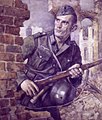Franz Eichhorst

Photo: Dorneth, 1936[1]
Franz Eichhorst (Berlin 7 September 1885 – 30 April 1948 Innsbruck) was a German painter, engraver and illustrator, one of a number of German artists known for his war paintings supporting the Nazi regime.[2]
Eichhorst volunteered for military service for Germany in World War I.[3] In the early 1920s, Eichhorst set up a summer studio in Matrei in Osttirol. There in 1928, he created one of his most well-known works, Mädchen mit Krug (Girl with Pitcher).[4]
In 1938 he created a series of war and Nazi propaganda murals representing the last 25 years of German history for the Schöneberg city hall in Berlin;[3][5] these were repainted and deleted at the end of World War II in May 1945. In April 1938, Adolf Hitler bestowed upon him the honorary title of Professor. Over 50 of his paintings were displayed at the Great German art exhibition (Große Deutsche Kunstausstellung) at the Haus der Kunst in Munich, including battle scenes from the Second World War, particularly those from the conflicts with Poland and Russia.[3]
-
"Lathe workers". Oil on paper, 59 x 70 cm.
-
"Poland fighter", propaganda painting of a Wehrmacht soldier, 1940
See also[edit]
Bibliography[edit]
- Julius Redzinski, Erinnerung an Stalingrad. Franz Eichhorst as a War Artist in the Nazi Era, in: Meike Hoffmann, Dieter Scholz (ed.), Unmastered Past? Modernism in Nazi Germany. Art, Art Trade, Curatorial Practice, Verbrecher Verlag, Berlin 2020, ISBN 978-3-95732-453-5, p. 112–131.
- Julius Redzinski, Von der Frontgemeinschaft zur Volksgemeinschaft. Franz Eichhorsts Freskenzyklus im Rathaus von Berlin-Schöneberg und im Kontext der nationaloszialistischen Interpretation des Ersten Weltkriegs, in: Iris Wenderholm, Nereida Gyllensvärd und Robin Augenstein (ed.), Die Sichtbarkeit der Idee. Zur Übertragung soziopolitischer Konzepte in Kunst und Kulturwissenschaften, De Gruyter, Berlin 2023, ISBN 978-3-11075-637-1, p. 109-128.
- Hans Rosenhagen, Franz Eichhorst, in: Velhagen & Klasings Monatshefte, Vol. 35, No. 12 (1921), p. 545–560.
References[edit]
- ^ Photo in the Bundesarchiv
- ^ McCloskey, Barbara. Artists of World War II, p. 50 (2005) (ISBN 978-0313321535) ("Paintings and drawings by Elk Eber, Fritz Erler, Franz Eichhorst, Wolf Willrich, Rudolf Hengstenberg, and other soldier-artists instead glorified Germany's war effort ...")
- ^ a b c Ernst Klee: Das Kulturlexikon zum Dritten Reich. Wer war was vor und nach 1945 (in German). S. Fischer, Frankfurt am Main 2007, p. 131.
- ^ "Bildbeilage: Mädchen mit Krug / Von Franz Eichhorst". Berlin Rom Tokio. 2 (1). January 1940.
- ^ Brett-Smith, Richard. Berlin '45: The Grey City, p.135 (Macmillan 1966) ("the murals of the leading Nazi war artist, Franz Eichhorst, to be found formerly in the Rauthaus Berlin-Schoneberg")
External links[edit]
- Nazi War Art 1940-44. Small gallery includes three Eichhorst paintings.


